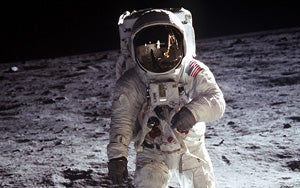Rover rolls on
ListenThe Mars Rover Opportunity is now 10 years old and still operating on the surface of the Red Planet. Saturday marks the 44th anniversary of the first manned moon landing. Nine NASA Apollo missions went to the moon. No astronauts have ben that far from earth since 1972 on Apollo 17. Night sky highlights: Tonight Venus is bright in the western sky after sunset; 45 minutes before sunrise, see Mars and Jupiter in an excellent pairing; tomorrow the moon will be just 3 degrees below Saturn in the evening sky.
July 15, 2013
[Dave Heller] Let’s extend birthday greetings and marvel at the durability of the Mars rover Opportunity with Derrick Pitts, chief astronomer at the Franklin Institute. Derrick, even the extended warranty ran out a long time ago for this vehicle.
[Derrick Pitts] It certainly did, 10 years ago is the time at which the Opportunity rover was sent to Mars. It was launched on July 7, 2003. Everybody knows its expected mission lifetime was about 90 days; it accomplished everything it had to do in those 90 days, but apparently the rover wasn’t done itself. So its continued to rove around the surface of Mars all these additional 9 years, if you will.
Is good science still being done?
Good science is still being done. You know we can’t say that the rover is in perfect condition, it isn’t. It has some problems. It has a bum leg, if you will, and it’s dragging it around. it’s actually turned itself around so it actually moves backwards, rolls backwards, rather than rolling forward, so that it can better get itself around with this bad wheel. But nonetheless, that’s not hampering it from moving to new locations or doing good science. The equipment is still good, communications are still good, still has enough power through its solar panels to be able to maneuver around and do what it needs to do, and so we don’t really see a point in the future when we really expect that it will stop working all together.
Is it running on solar or on nuclear power?
Runs on solar power, all of the rovers on the surface of Mars run on solar power with the exception of the most recent one, the Mars Laboratory which is using a radioisotope [thermoelectric] generator to produce electricity. Its lifespan, its power supply, is expected to last 10 years alone.
-
Nuclear Mars Rover | Multi-Mission Radioisotope Thermoelectric Generator
Let’s pay tribute to another anniversary, arguably America’s last epic collective hurrah 44 years ago.
Yes, you’re absolutely right. It was 44 years ago that the first human set foot on the moon. Americans Neil Armstrong and Buzz Aldrin set down on the surface of the moon for a brief few hours on this day coming up, July 20, [making] the longest trip humans have ever made. It’s the most distant location humans have ever been in the solar system, and in fact, if you look at all the manned missions that have been conducted in the history of the Space Race, the lunar trips were the most distant we’ve ever been. So if you look at the last lunar mission which was 1972, Apollo 17, at that time that was the greatest distance we had travelled and it’s still the greatest distance humans have ever travelled in space.
And that Apollo 17 mission was completed, I suppose few thought that it would take this long to either return to the moon or beyond.
The expectation was that we would mount expeditions back to the moon, get that programming started pretty soon. The Space Shuttle Program was … under design and development as a cheap and fast way to provide us easy access to low Earth orbit. Turned out to be neither one of those, cheap nor fast, but it certainly did give us capacity. But it’s only now, some 44 years later that we’re really seriously trying to figure out — not do it, but figure out — how do we get there? The major change in the horizon of what might happen is that it may not be the national agency NASA that returns humans to the moon first. Not saying that it could be another country, certainly other countries have designs, but it may be that an independent non-governmental agency or corporation might make that happen.
Though with the myriad of technological advances in the ensuing decades, one might argue that again the fastest and the cheapest way to do good science on the moon is through unmanned missions.
Well there’s no doubt about that. There’s absolutely no question. The fastest way to do good science is to do it as an unmanned robotic mission. We’ve certainly learned that with Mars; we’ve been able to do great science on Mars, and we’ve been able to reduce the risk for human life in these adventures dramatically. And the cost, of course, is far lower to do it robotically than it is to do it with people involved. But the thing about people being involved in any endeavor is that people always want to be out there. People want to be explorers. So we find that no matter how much we think that we’re going to completely eliminate, or we may have designs to eliminate humans from this, somebody somewhere is figuring out a way to make it happen with people involved. And in fact when you look at how we do exploration, one can still argue that the best equipment that you can put anywhere for exploration is humans. The problem is that it can be very, very risky. It can lead to fatal consequences, and so many explorers have had that happen to them in the course of just exploring this planet alone! So we can’t discount that same thing, that same fate, that will come to explorers looking to learn more about our solar system and our galaxy in person.
“The fastest way to do good science is to do it as an unmanned robotic mission … But the thing about people being involved in any endeavor is that people always want to be out there. People want to be explorers.”
Derrick Pitts
Of course it’s relatively risk-free and cheap to explore the night sky from terra firma. Planets aplenty this week, direct our gaze.
So much to do. We can start in the morning, if you’d like, 45 minutes before sunrise low on the eastern horizon we’ll find Jupiter and Mars together. And as the morning progresses, moving more towards sunrise, these objects will rise higher in the eastern sky, and they’ll continue to do that through the course of the month — they’ll rise earlier and earlier. And the other thing that’s happening at the same time is that sunrises are starting to come later and later also, so these things will work together to your advantage to observe. So in the morning we have objects to see, but over the evening sky of course we have Venus, bright over on the western horizon, above the western horizon after sunset. The moon is not too far from Spica tonight; Spica’s the brightest star in the constellation Virgo. And of course if we wait a little bit later we can see Saturn in the evening sky as well. Tomorrow the moon will be just three degrees below Saturn, so that makes it easy to recognize without much difficulty at all.
WHYY is your source for fact-based, in-depth journalism and information. As a nonprofit organization, we rely on financial support from readers like you. Please give today.





